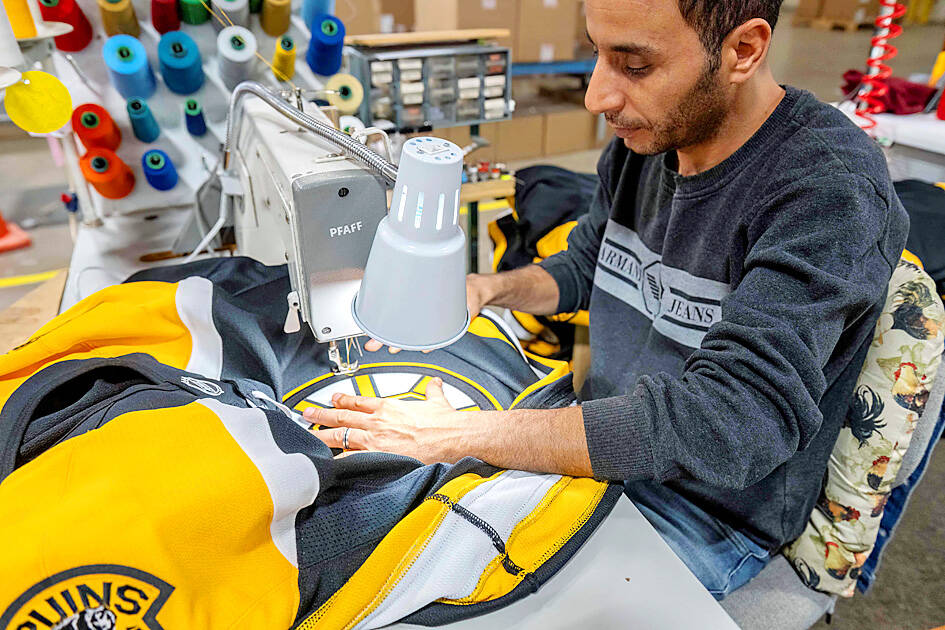As a sport that involves men colliding at high speeds, bare-knuckle brawls, and a fair number of players with missing front teeth, ice hockey is not commonly linked to high fashion.
However, SP Apparel, a Canadian company based east of Montreal that makes the jerseys worn by all 32 NHL teams, says superior material and meticulous craftmanship have kept it at the top of the game.
“It’s like haute couture,” said Steve Berard, president of the company with 260 employees in the city of Saint-Hyacinthe in Quebec.

Photo: AFP
SP Apparel has been making jerseys for the NHL for 50 years, through nearly half the league’s 107-year history.
For the last 25 years, it has also made the uniforms for all national ice hockey teams competing at the Olympics. Being based in a hockey-mad nation, which has consistently produced many of the sport’s top stars, has helped SP Apparel retain its primacy in hockey apparel, Berard said.
However, the quality of the product is paramount, he said.
“These are not jerseys made on a production line,” Berard said. “There are 90 pieces to assemble, with different colors and materials.”
The company says its products are made to withstand particularly brutal wear and tear.
So, while there are a few industrial machines like laser fabric cutters at its 9,000m2 factory, seamstresses with simple sewing machines do the assembly work.
An NHL jersey is worn only five to 20 times on average. That depends partly on the individual player’s amount of ice time, and partly on his style of play in a sport in which fights can involve grabbing or even tearing an opponent’s jersey.
The company estimates that it makes 300,000 to 500,000 units per year, including hockey jerseys and socks, as well as the uniforms it makes for major junior Canadian Hockey League and baseball teams (but not those in the major leagues).
During the past Winter Olympics, SP Apparel sent tailors on site to make any repairs or adjustments required during the Games.
The company also accommodates “special requests for certain players,” notably Pittsburgh Penguins star Sidney Crosby, SP Apparel executive director Tania Berlinguette said.
“We make his socks slightly larger because his calves are a little bigger than average,” Berlinguette said.
Staff said the most popular jersey on the factory floor belongs to the Vegas Golden Knights, with fine detailing that nods to a knight’s mesh armor, and the words “Always Advance. Never Retreat” on the inner collar.
Lyne Gagne, who has worked at SP Apparel for 35 years and now oversees a department responsible for a jersey’s final detailing, said the work has changed considerably over the years.
Jerseys are now “much more adapted to the players’ movements,” she said.
“They used to be straight cut, with big sleeves, with five to 10 pieces. Now they hug the body and the material is different,” she said.
The predominance of SP Apparel’s jerseys at hockey’s highest levels is a “source of pride” for employees, she said.
“When you watch a hockey game, you know that the jersey has passed through our hands,” she added.

Nvidia Corp’s demand for advanced packaging from Taiwan Semiconductor Manufacturing Co (TSMC, 台積電) remains strong though the kind of technology it needs is changing, Nvidia CEO Jensen Huang (黃仁勳) said yesterday, after he was asked whether the company was cutting orders. Nvidia’s most advanced artificial intelligence (AI) chip, Blackwell, consists of multiple chips glued together using a complex chip-on-wafer-on-substrate (CoWoS) advanced packaging technology offered by TSMC, Nvidia’s main contract chipmaker. “As we move into Blackwell, we will use largely CoWoS-L. Of course, we’re still manufacturing Hopper, and Hopper will use CowoS-S. We will also transition the CoWoS-S capacity to CoWos-L,” Huang said

Nvidia Corp CEO Jensen Huang (黃仁勳) is expected to miss the inauguration of US president-elect Donald Trump on Monday, bucking a trend among high-profile US technology leaders. Huang is visiting East Asia this week, as he typically does around the time of the Lunar New Year, a person familiar with the situation said. He has never previously attended a US presidential inauguration, said the person, who asked not to be identified, because the plans have not been announced. That makes Nvidia an exception among the most valuable technology companies, most of which are sending cofounders or CEOs to the event. That includes

TARIFF TRADE-OFF: Machinery exports to China dropped after Beijing ended its tariff reductions in June, while potential new tariffs fueled ‘front-loaded’ orders to the US The nation’s machinery exports to the US amounted to US$7.19 billion last year, surpassing the US$6.86 billion to China to become the largest export destination for the local machinery industry, the Taiwan Association of Machinery Industry (TAMI, 台灣機械公會) said in a report on Jan. 10. It came as some manufacturers brought forward or “front-loaded” US-bound shipments as required by customers ahead of potential tariffs imposed by the new US administration, the association said. During his campaign, US president-elect Donald Trump threatened tariffs of as high as 60 percent on Chinese goods and 10 percent to 20 percent on imports from other countries.

INDUSTRY LEADER: TSMC aims to continue outperforming the industry’s growth and makes 2025 another strong growth year, chairman and CEO C.C. Wei says Taiwan Semiconductor Manufacturing Co (TSMC, 台積電), a major chip supplier to Nvidia Corp and Apple Inc, yesterday said it aims to grow revenue by about 25 percent this year, driven by robust demand for artificial intelligence (AI) chips. That means TSMC would continue to outpace the foundry industry’s 10 percent annual growth this year based on the chipmaker’s estimate. The chipmaker expects revenue from AI-related chips to double this year, extending a three-fold increase last year. The growth would quicken over the next five years at a compound annual growth rate of 45 percent, fueled by strong demand for the high-performance computing